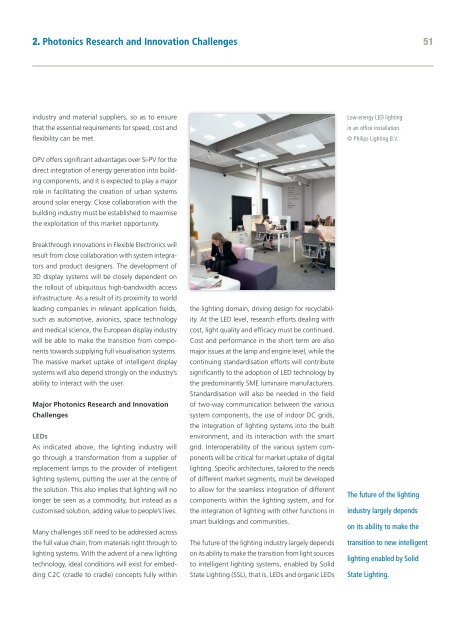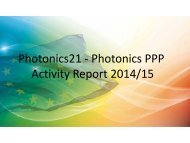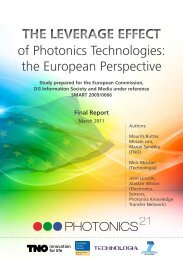Towards 2020 – Photonics driving economic growth in Europe
Create successful ePaper yourself
Turn your PDF publications into a flip-book with our unique Google optimized e-Paper software.
2. <strong>Photonics</strong> Research and Innovation Challenges<br />
51<br />
<strong>in</strong>dustry and material suppliers, so as to ensure<br />
that the essential requirements for speed, cost and<br />
flexibility can be met.<br />
Low-energy LED light<strong>in</strong>g<br />
<strong>in</strong> an office <strong>in</strong>stallation.<br />
© Philips Light<strong>in</strong>g B.V.<br />
OPV offers significant advantages over Si-PV for the<br />
direct <strong>in</strong>tegration of energy generation <strong>in</strong>to build<strong>in</strong>g<br />
components, and it is expected to play a major<br />
role <strong>in</strong> facilitat<strong>in</strong>g the creation of urban systems<br />
around solar energy. Close collaboration with the<br />
build<strong>in</strong>g <strong>in</strong>dustry must be established to maximise<br />
the exploitation of this market opportunity.<br />
Breakthrough <strong>in</strong>novations <strong>in</strong> Flexible Electronics will<br />
result from close collaboration with system <strong>in</strong>tegrators<br />
and product designers. The development of<br />
3D display systems will be closely dependent on<br />
the rollout of ubiquitous high-bandwidth access<br />
<strong>in</strong>frastructure. As a result of its proximity to world<br />
lead<strong>in</strong>g companies <strong>in</strong> relevant application fields,<br />
such as automotive, avionics, space technology<br />
and medical science, the <strong>Europe</strong>an display <strong>in</strong>dustry<br />
will be able to make the transition from components<br />
towards supply<strong>in</strong>g full visualisation systems.<br />
The massive market uptake of <strong>in</strong>telligent display<br />
systems will also depend strongly on the <strong>in</strong>dustry’s<br />
ability to <strong>in</strong>teract with the user.<br />
Major <strong>Photonics</strong> Research and Innovation<br />
Challenges<br />
LEDs<br />
As <strong>in</strong>dicated above, the light<strong>in</strong>g <strong>in</strong>dustry will<br />
go through a transformation from a supplier of<br />
replace ment lamps to the provider of <strong>in</strong>telligent<br />
light<strong>in</strong>g systems, putt<strong>in</strong>g the user at the centre of<br />
the solution. This also implies that light<strong>in</strong>g will no<br />
longer be seen as a commodity, but <strong>in</strong>stead as a<br />
customised solution, add<strong>in</strong>g value to people’s lives.<br />
Many challenges still need to be addressed across<br />
the full value cha<strong>in</strong>, from materials right through to<br />
light<strong>in</strong>g systems. With the advent of a new light<strong>in</strong>g<br />
technology, ideal conditions will exist for embedd<strong>in</strong>g<br />
C2C (cradle to cradle) concepts fully with<strong>in</strong><br />
the light<strong>in</strong>g doma<strong>in</strong>, <strong>driv<strong>in</strong>g</strong> design for recyclability.<br />
At the LED level, research efforts deal<strong>in</strong>g with<br />
cost, light quality and efficacy must be cont<strong>in</strong>ued.<br />
Cost and performance <strong>in</strong> the short term are also<br />
major issues at the lamp and eng<strong>in</strong>e level, while the<br />
cont<strong>in</strong>u<strong>in</strong>g standardisation efforts will contribute<br />
significantly to the adoption of LED technology by<br />
the predom<strong>in</strong>antly SME lum<strong>in</strong>aire manufacturers.<br />
Standardisation will also be needed <strong>in</strong> the field<br />
of two-way communication between the various<br />
system components, the use of <strong>in</strong>door DC grids,<br />
the <strong>in</strong>tegration of light<strong>in</strong>g systems <strong>in</strong>to the built<br />
environment, and its <strong>in</strong>teraction with the smart<br />
grid. Interoperability of the various system components<br />
will be critical for market uptake of digital<br />
light<strong>in</strong>g. Specific architectures, tailored to the needs<br />
of different market segments, must be developed<br />
to allow for the seamless <strong>in</strong>tegration of different<br />
components with<strong>in</strong> the light<strong>in</strong>g system, and for<br />
the <strong>in</strong>tegration of light<strong>in</strong>g with other functions <strong>in</strong><br />
smart build<strong>in</strong>gs and communities.<br />
The future of the light<strong>in</strong>g <strong>in</strong>dustry largely depends<br />
on its ability to make the transition from light sources<br />
to <strong>in</strong>telligent light<strong>in</strong>g systems, enabled by Solid<br />
State Light<strong>in</strong>g (SSL), that is, LEDs and organic LEDs<br />
The future of the light<strong>in</strong>g<br />
<strong>in</strong>dustry largely depends<br />
on its ability to make the<br />
transition to new <strong>in</strong>telligent<br />
light<strong>in</strong>g enabled by Solid<br />
State Light<strong>in</strong>g.






